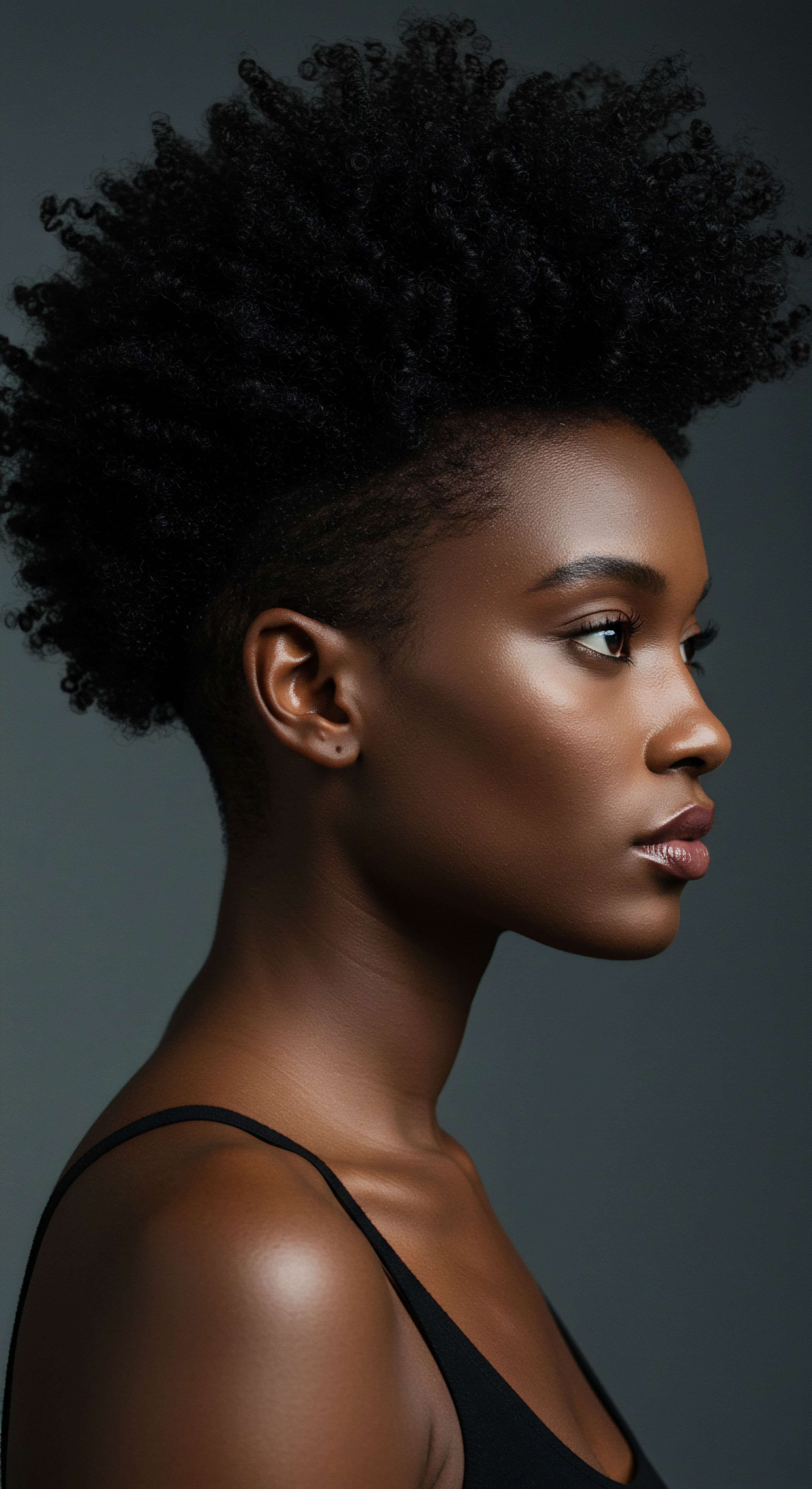
Roots
The whisper of ancient winds, carrying tales across sun-baked lands and through hushed forest groves, often settles upon a quiet truth ❉ hair has always held more than strands and pigment. It is a crown, a canvas, a statement. When we consider the coverings worn by our ancestors, from the simplest cloth to the most elaborate headdress, a gentle curiosity awakens. Could these coverings truly have been only about shielding against the sun’s ardent kiss or the biting chill of a winter night?
The answer, as we listen closely to the echoes of history and the soft rustle of tradition, reveals itself as a resounding ‘no.’ These adornments, often dismissed in modern thought as mere practicalities, held layers of meaning, speaking volumes about identity, community, and the very fabric of ancient lives. They were not simply garments; they were silent communicators, powerful emblems, and guardians of much more than physical comfort.

Early Expressions of Identity
From the earliest known human societies, the ways people presented themselves, particularly their hair, served as a primary form of non-verbal communication. A covering over the head, whether a simple band or a draped cloth, instantly conveyed a wealth of information. This was a visual language understood across social strata and cultural boundaries. It spoke of belonging, of role, of who one was within the larger collective.
Consider the nomadic tribes, where a distinctive headwrap might have marked a specific clan, or early agricultural communities where a certain style denoted a particular familial lineage. The earliest records of women wearing head coverings trace back to 13th century BC Assyria, where noblewomen adopted them to set themselves apart from those of lower social standing. This distinction was not just about protection; it was about asserting a place in the world.
Ancient hair coverings were not solely for physical protection; they served as powerful, unspoken communicators of social standing and identity within communities.
These initial forms of hair coverings were deeply tied to the foundational elements of communal living. They were extensions of self, proclaiming affiliations and distinctions without uttering a single word.
- Clan Affiliation ❉ Headwear could identify a person’s tribal or familial group, creating a visible bond among members.
- Social Hierarchy ❉ The materials, ornamentation, or style of a covering often signaled one’s rank or status within the community.
- Personal Role ❉ Specific coverings might indicate a person’s occupation, such as a hunter, a gatherer, or a spiritual guide.

What Did Ancient Hair Coverings Physically Defend?
While the symbolic dimensions of head coverings are compelling, their practical utility remains a foundational aspect of their historical prevalence. The elemental forces of nature have always dictated certain human adaptations. In scorching deserts, a loose, flowing fabric offered respite from the sun’s relentless glare, shielding the scalp from burns and the eyes from harsh light. For those living in colder climes, animal skins or tightly woven caps provided warmth, insulating against biting winds and freezing temperatures.
These practical benefits were undeniable, a primary reason for the adoption of headwear across diverse geographies. The ancient Egyptians, for instance, covered their heads with fine linen to protect against the sun.
Beyond climate control, coverings offered defense against environmental hazards. In agrarian societies, a headwrap could keep dust, debris, or insects from hair and eyes during fieldwork. For those engaged in crafts or early industries, it might have offered a basic layer of protection from sparks, chemicals, or entanglement in rudimentary machinery. These tangible benefits, while seemingly simple, were crucial for daily survival and comfort, establishing the initial, pragmatic groundwork upon which more complex cultural meanings were built.

Ritual
Stepping from the foundational understandings of ancient head coverings, we arrive at the intricate realm of ritual and tradition. Here, the practicalities of physical defense begin to recede, allowing a richer tapestry of purpose to come into focus. Consider the subtle shift in atmosphere when a person prepares for a significant event, a ceremony, or a sacred gathering. There is a deliberate intention, a mindful preparation that extends to every detail of appearance, particularly the hair.
Head coverings, in this context, become more than mere adornment; they are conduits of meaning, tools for transformation, and vessels for spiritual connection. They carry the weight of generations, whispering ancient wisdom into the present moment. This section invites a deeper look into the practices that elevated hair coverings from simple cloth to profound instruments of cultural and spiritual expression.

Signifiers of Status and Life Transitions
Across various ancient societies, head coverings frequently acted as clear markers of social standing and significant life events. Their presence or absence, their style, or their material often communicated a person’s marital status, age, or even their position within a hierarchical structure. In ancient Rome, married women often covered their heads in public, a sign of modesty and their married state.
Unmarried women, by contrast, typically did not cover their heads. This distinction was not merely a custom; it was often enforced by societal expectations and even sumptuary laws.
A particularly compelling example appears in a 13th century B.C. Assyrian text, which stipulated that veiling was reserved exclusively for women of the aristocracy, with prostitutes and those of lower social status expressly forbidden from wearing them. This rule created a stark visual divide, reinforcing social stratification through sartorial choice. Similarly, in many African cultures, headwraps signify marital status, wealth, or social rank.
The Nigerian gele, a traditional headwrap, is worn for celebrations and embodies elegance and cultural pride. These coverings, therefore, functioned as a public declaration of a woman’s standing within her community, shifting with her life’s progress.
Beyond marital status, headwear could denote other significant transitions. For instance, in some indigenous traditions, specific headpieces were worn during rites of passage, marking a child’s entry into adulthood, a warrior’s initiation, or a spiritual leader’s ascension. These were not simply accessories; they were ceremonial vestments, imbued with the power of the transition itself.
| Culture Ancient Assyria |
| Head Covering Practice Veiling by aristocratic women |
| Significance Exclusion of lower classes and prostitutes; marker of high social status. |
| Culture Ancient Rome |
| Head Covering Practice Married women covering heads in public |
| Significance Symbol of modesty and marital status; unmarried women typically uncovered. |
| Culture Ancient Greece |
| Head Covering Practice Varied veiling practices |
| Significance Some veils like the kredemnon covered head and shoulders, often associated with piety for wealthy women. |
| Culture African Cultures |
| Head Covering Practice Headwraps (e.g. Gele) |
| Significance Indication of marital status, wealth, or social rank; cultural pride. |
| Culture Head coverings consistently communicated social standing and life changes across diverse ancient societies. |

Sacred Shields and Spiritual Connection
The connection between hair coverings and the spiritual realm runs deep through antiquity. Many ancient cultures believed the head to be a conduit for divine energy, a sacred space where the human and spiritual worlds met. Covering the head, then, became a practice of reverence, a way to honor the divine, or to protect oneself from spiritual influences. In Orthodox Judaism, for instance, women cover their hair after marriage to signify modesty and spiritual purity.
This practice is rooted in the understanding that hair holds intimate connotations, and covering it preserves a sacred bond within marriage. Similarly, Jewish men wear a kippah as a sign of respect and recognition of God’s presence.
The practice of covering the head in ancient cultures often reflected a profound spiritual intention, acting as a visible sign of reverence, modesty, or a channel for divine connection.
Christianity also saw head coverings tied to modesty and respect, with nuns wearing veils as a sign of devotion. Early Christian writers viewed the veil as a form of spiritual armor, protecting women from external gazes and symbolizing obedience. This spiritual dimension extended beyond formalized religion into broader cultural beliefs, where specific headwear might be worn during rituals to amplify spiritual power or to denote a sacred role, such as that of a priestess or shaman. These coverings were not merely decorative; they were charged with symbolic weight, participating in the very act of spiritual practice.

Relay
Moving beyond the initial understandings of physical defense and the immediate cultural cues, we arrive at a more sophisticated understanding of ancient hair coverings. This section explores the intricate ways these seemingly simple garments functioned as complex communicators within ancient societies, reflecting not only individual status but also the broader currents of political power, collective identity, and even subtle forms of resistance. Here, we delve into the deeper, sometimes hidden, layers of meaning, drawing upon historical accounts and scholarly observations to illuminate the profound social and psychological roles these coverings played. The threads of science, culture, and individual expression intertwine, inviting us to consider the less obvious forces that shaped human adornment in antiquity.

Hair Coverings as Political and Social Statements
The choice to cover one’s hair, or indeed to leave it uncovered, was rarely a neutral act in ancient societies. Headwear frequently served as a powerful instrument of social control, a visual code that dictated and reflected societal norms. In the Roman Empire, for example, fashion was heavily legislated, and a person’s status could often be determined by their dress.
A married Roman woman typically had her head covered, while an unmarried maiden’s head remained uncovered, marking her virginity. This was not merely a custom; it was a public display of adherence to prescribed roles.
The political dimension of head coverings also cannot be overlooked. Royal headwear, such as crowns or elaborate turbans, served as unmistakable images of authority and power. The design of crowns in Persian art, for instance, evolved over different historical periods, directly reflecting changes in political and social currents. A change in a ruler’s headdress could signal a shift in power dynamics or a new ideological direction.
In the Timurid period, the design of crowns in paintings was significantly influenced by religious and political factors, with new kings minting coins displaying their unique crowns to signify their reign. This visual lexicon was a silent yet potent form of governance, reinforcing hierarchies and maintaining order.
A striking historical illustration of this power dynamic appears in 18th-century colonial America. As African women were forcibly enslaved, headwraps, which in their native lands signified social status and cultural identity, were mandated as symbols of subservience. In South Carolina, a 1735 law restricted enslaved Black women from wearing decorated or embellished clothing, including festive headwraps. Later, in 1784, Louisiana Governor Esteban Rodriguez Miró passed the “Edict of Good Government,” which required Black women to wear their hair bound in a kerchief or “tignon.” This governmental decree transformed a garment of cultural pride into a marker of oppression, stripping agency and identity through enforced dress.
The headwrap, originally a vibrant expression of Black womanhood and distinction in Africa, became a tool of dehumanization, demonstrating how external forces could manipulate personal adornment to enforce social control. This historical episode underscores the profound political weight carried by seemingly simple articles of clothing, moving far beyond any basic physical defense.

Psychological Resonance and Collective Identity
Beyond overt political and social signaling, ancient hair coverings held a subtle yet potent psychological resonance. They contributed to a sense of collective identity, fostering cohesion within groups and distinguishing them from others. For Jewish communities in the first century, the practice of head covering for women, while possibly influenced by broader Roman customs, also served to maintain a distinct ethnic identity. The act of covering could instill a feeling of shared belonging, a visible bond among those who adhered to similar traditions or beliefs.
The psychological impact extended to individual self-perception. Wearing a specific head covering could alter how a person perceived themselves, instilling a sense of modesty, piety, or dignity. In some contexts, it offered a form of “armoring,” a psychological shield that contributed to confidence and self-assurance. This was particularly true for women, where the veil could serve as a “necessary boundary” in highly patriarchal societies, protecting them from unwanted attention and signaling their unavailability.
This is not to say that the practice was always voluntary or universally empowering, as evidenced by instances of enforced veiling. However, the psychological benefits for those who chose or accepted the practice, seeing it as an expression of their values, are undeniable.
Consider the complexities of veiling practices in Late Antiquity, where early Christian churchmen vigorously promoted head coverings for women as a sign of Christian modesty and submission. Yet, visual and material evidence from the period suggests that women often wore thin, delicate coverings, perhaps even using hairpieces beneath them, indicating a desire to maintain aesthetic appeal while nominally adhering to religious expectations. This interplay highlights a fascinating tension between prescribed norms and individual expression, revealing that even within seemingly rigid frameworks, personal agency found ways to manifest. The hair covering, therefore, was not a static symbol, but a dynamic canvas upon which societal expectations, personal piety, and individual aesthetic preferences were constantly negotiated.

Reflection
As we gently draw our exploration to a close, the story of ancient hair coverings unfolds not as a simple chronicle of fabric and form, but as a testament to human ingenuity in expressing the intangible. From the very first wrap that shielded against a harsh sun to the intricately crafted headdress signifying lineage or devotion, these coverings have always held a deeper resonance. They speak to our inherent need for connection, for belonging, for a quiet declaration of who we are in the grand unfolding of time. The whispers of old traditions remind us that our personal presentation, particularly the way we adorn our hair, remains a powerful, living language, connecting us to the past while shaping our present identities.

References
- Crane, Diana. “The Social Meanings of Hats and T-shirts.” In Fashion and Its Social Agendas ❉ Class, Gender, and Identity in Clothing. University of Chicago Press, 2000.
- Lewellyn-Jones, Lloyd. Aphrodite’s Tortoise ❉ The Veiled Woman of Ancient Greece. Classical Press of Wales, 2013.
- Marlowe, Michael D. “Headcovering Customs of the Ancient World ❉ An Illustrated Survey.” Bible Research, 2005.
- Massey, Preston. “Veiling Among Men in Roman Corinth.” In Paul and the Corinthians ❉ Studies on a Community in Conflict, edited by C. Marvin Pate and Calvin B. Hays. Baker Academic, 2007.
- Sebesta, Judith Lynn, and Larissa Bonfante, editors. The World of Roman Costume. University of Wisconsin Press, 1994.
- Stol, Marten. Women in Ancient Mesopotamia. De Gruyter, 22-8.
- Thompson, Cynthia. “Hairstyles, Headcoverings, and the Corinthian Woman ❉ A Reconsideration of 1 Corinthians 11:2-16.” Journal of Biblical Literature 115, no. 4 (1996) ❉ 617-31.
- Vogelsang-Eastwood, Gillian, and Willem Vogelsang. Covering the Body ❉ A History of Clothing. Brill, 2008.
- Watson, Francis. Paul and the Corinthian Church ❉ A Reassessment of 1 Corinthians 11:2-16. T&T Clark, 2004.